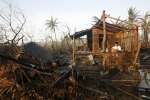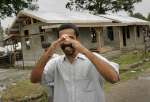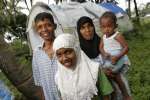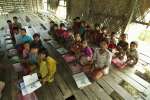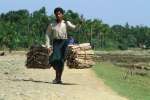- Text size
 |
|  |
|  |
| 
- Français
As thousands continue to flee Myanmar, UNHCR concerned about growing reports of abuse
News Stories, 10 June 2014
GENEVA, June 10 (UNHCR) – The UN refugee agency on Tuesday said it was receiving increasing reports of abuse and exploitation as people continue to seek safety and stability overseas two years after inter-communal violence erupted in Myanmar's Rakhine state.
"UNHCR estimates more than 86,000 people have left on boats since June 2012. This includes more than 16,000 people in the second half of 2012, some 55,000 in 2013 and nearly 15,000 from January to April this year," spokesman Adrian Edwards told journalists in Geneva. "The majority are Rohingya, although anecdotally the proportion of Bangladeshis has grown this year," he added.
While 730 people are reported to have died on this journey in the second half of 2012, that number fell to 615 for all of last year, possibly due to the use of larger, more stable cargo boats by smuggling networks.
"People who have made it to Thailand, Malaysia or Indonesia have told UNHCR staff about overcrowded boats that sometimes lost their way or developed engine problems. Some ran out of food and water due to the long periods at sea. Some who died on the boats are said to have been thrown overboard," Edwards noted.
Across the region, UNHCR continues to advocate for temporary stay arrangements for the Rohingya until the situation stabilizes sufficiently in Rakhine state for them to return. These arrangements involve acquiring the documented right to remain in the host country for the designated period, protection against arbitrary detention, respect for family unity, guarantees of shelter as well as access to services and lawful work opportunities.
Some of those who have reached Thailand speak of being taken to smugglers' camps in the jungles or hills near the Thailand-Malaysia border. There they were kept for months in overcrowded camps and sometimes even cages until their families could pay for their release. They recount daily beatings and that some people died. No one was allowed to move except for limited toilet breaks. They spent their days sitting in confined spaces and nights sleeping upright or in foetal position due to the lack of space.
The Thai authorities have conducted several raids on these camps, rescuing hundreds of people, including some 500 Rohingya earlier this year. UNHCR is providing relief and advocating for a more clearly defined temporary protection regime during their stay in Thailand that would include, for example, access to education for the children and enhanced freedom of movement. "Most immediately, to facilitate recovery and improve conditions of stay from the current immigration detention centres, we have offered to support rehabilitation centres where families can stay together and basic community activities can be organized while longer-term solutions are sought. The most vulnerable cases are submitted for consideration by resettlement countries," Edwards said.
In Malaysia, there have been increased reports of smuggling and trafficking from Thailand of people from Myanmar, including those who are of concern to UNHCR. Reliable reports indicate these groups frequently face abuse, ill-treatment, exploitation and extortion by smuggling gangs. An increasing number are in poor physical and emotional health – malnourished and unable to walk. UNHCR staff in Kuala Lumpur have helped more than 120 Rohingya identified with Beriberi due to Vitamin B1 deficiency.
"UNHCR is advocating for the prompt release from detention of any detained Rohingya and others of concern. We also believe that improved access to health and other support services, including lawful employment opportunities, will allow refugees to be self-reliant," spokesman Edwards stressed. UNHCR has registered more than 35,000 Rohingya in Malaysia over the years.
In Indonesia, the Rohingya now number more than 1,200 people. Registration numbers peaked during the second half of 2013 with 474 new arrivals after several boats arrived from Thailand; others also crossed over from Malaysia. This year the trend of arrivals has dropped to only 56 people up to May. In addition, from January to May this year, 99 Rohingya, including a small number of secondary movers from Malaysia, are reported to have returned to Malaysia. Frustrations and tensions are rising due to the lack of solutions.
UNHCR's Edwards said that in Bangladesh, which has hosted Rohingya refugees for more than two decades, there have been several positive developments in the last year. Education was extended to middle school level (ages 13-14 years) in the two official camps hosting more than 30,000 Rohingya refugees.
"We have also enhanced efforts to address gender-based violence in the camps, including by facilitating the deployment of policewomen. In addition, the government has also agreed to the improvement of services in the camps including shelter and livelihood opportunities," Edwards said, while welcoming the Bangladeshi government's initiative to "list" an estimated 200,000 to 500,000 unregistered Rohingya in Bangladesh.
In Rakhine state, meanwhile, some 140,000 people remain displaced – the majority of them Rohingya, with smaller numbers of Rakhine, Kaman and other ethnicities. Aid workers have resumed humanitarian assistance following attacks on UN and NGO premises in Sittwe in late March. "While UNHCR remains committed to providing temporary shelters, coordinating camp management and addressing a difficult protection situation, we are wary of activities that could entrench segregation and protracted displacement. The challenge is to move from an emergency phase towards durable solutions," Edwards said.








